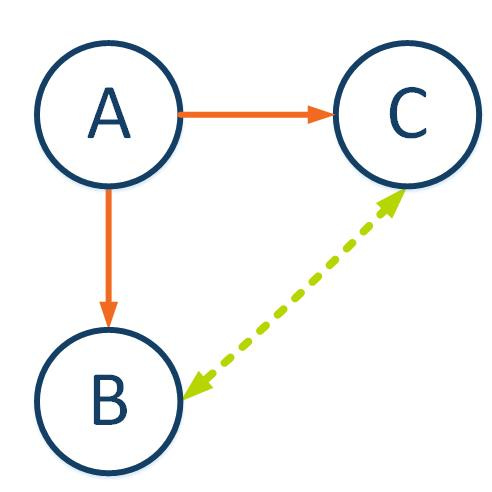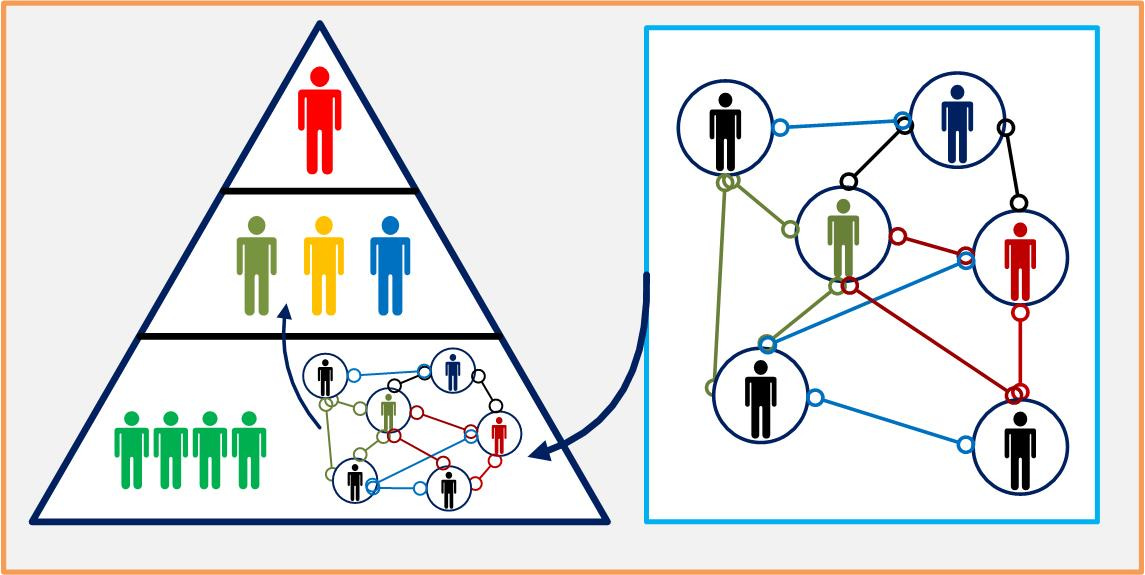The Trust Engine of Networks of Relationships
How we need rich networks of both strong and weak ties to create the conditions for trust today.
Trust is the key to the integrity of every social and organizational structure. Yet, trust is at a low standard in our society today. We are more interested in setting ourselves in opposition to people that we believe are our antagonists, or worse, our enemies. The reasons for this I describe in my post, Social Capital and Mimetic Violence.
To counter this trend, we need to restore trust to the institutions of society. This is not easy. The social and organizational structures are presently not compatible with networks of trust.
Two years ago, I wrote a pair of short books in response to a question about corruption. The second of the pair is Where Did Trust Go? Restoring Authority and Accountability in Organizations. (The first book is Seeing Below The Surface of Things: The Brokenness of the Modern Organization.) I wrote in the trust book.
“The relationship of authority and accountability is a fundamental one in every organization and society at large. Their interaction is not a connection point like a tongue-and-groove piece of furniture or the bolt-and-nut fastener in a machine. Instead, it represents something alive and whole. An organization or society as a living organism, not a mechanical machine. It is a human creation. Yet, when it loses its human connection, it ceases to live.”
Now, let’s place this question of the relation of authority to accountability into the context of Networks of Relationships. We can begin to see how trust is missing in many organizations. To understand the patterns of behavior that erode trust, we need to understand a specific aspect of networks of relationships.
Ronald Burt, an expert on social capital in the context of networks writes about the relationship between strong ties and weak ties. This is the same idea that Mark Granovetter wrote about as “the strength of weak ties.” It would appear that many people and organizations see these two facets of networks as alternative choices. This is not true. We need networks of strong ties with weak ties as their complement.
Ron Burt writes about this as the difference between brokerage and closure. In this image, A knows both B and C. B and C do not know one another.
The relationship between A & B and A & C manifests itself with trust. The trust that A has in both B & C leads to his introduction of them to one another. He has a purpose for this that brokers a new relationship that brings the kind of closure that produces social capital.
It is what I want to call the Trust Engine.
What is that? It is the relationship connection that we form when a structural hole is closed. A structural hole is a gap that exists between two people who both know a third person, but do not know each other.
The Trust Engine is You and Me
Trust is treated as a word, not unlike leadership, that has many meanings and little force of impact. I understand trust as the glue that holds a social and organizational structure together. As a glue, it is not a single element but many required to build a tight, cohesive team.
I had a client where one person on the team was fomenting mistrust through a belief that someone was out to destroy the company. My project was not designed to address people’s mistrust. But it was a problem that was going to inhibit my ability to be successful. With the approval of the CEO, I addressed the issue with the gentleman. As a result, he left the company. While that was not my intention, it did resolve an element of mistrust within the social culture of the company. As a result, pent-up demand for trust within the company was released and the project led to a series of highly successful projects that broad respect and honor to them. Once done, we demonstrated through our project that trust was at the heart of “the persistent, residual culture of relationships” with the people of the company.
The trust engine in every organization is the internal network of relationships between people. These relationships may be strong or weak. They may be underdeveloped and neglected. However, by developing a network of relationships culture within your organization as this diagram shows, then you are going to find power distributed to every individual in a way where their performance engenders greater and greater of trust in the operation of the company.
The Product of Networks is Trust
We all are trust engines. We want people to trust us. It is the engine of social capital. It makes things easier in our work, in our communication, in our resolving of disputes, and in how we plan for the future.
Destroy trust and our world becomes filled with conflict and violence. Conflict and violence are the products of mistrust or anti-trust and is deployed to gain power over people. Where you see power without accountability, you have an environment where trust is missing.
Here’s how your trust engine can work.
We treat people with respect.
We do not sit in judgment of them. Rather, we seek to discern their motives and purposes.
We do not seek to marginalize them.
We seek to establish relationships of understanding.
We, ultimately, seek to establish a relationship of mutual commitment and accountability.
These represent the closure of a structural hole within our network of relationships. We accomplish this by being persons of respect, trust, and mutual accountability. When this is missing, we find conflict, violence, and the use of force to dominate people and structures.
Enhancing Bandwidth and Echo for Trust building
Ronald Burt uses two metaphorical descriptions to help us understand how our networks of relationships can grow as engines of trust. In his essay, Bandwidth and Echo: Trust, Information, and Gossip in Social Networks, he writes.
“There are two schools of thought on how network structures create the competitive advantage known as social capital. One school focuses on the advantages of closure. A network is closed to the extent that people in it are connected by strong relationships. Typical forms of closure are dense networks in which people are connected indirectly through mutual relations with a few leaders at the center of the network. Both forms provide numerous communication channels, which facilitate the enforcement of sanctions against misbehavior. Closure lowers the risk of trust, and so facilitates collaborative efforts that require trust. A second school of thought focuses on the advantages of brokerage. Markets and organizations are assumed to be a network of interdependent groups in which information flows at higher velocity within than between groups such that the separate groups come to know about different things. Boundaries between groups define holes in social structure, “structural holes,” creating a competitive advantage in networks that span the holes. Brokerage across structural holes is an advantage for detecting and developing new ideas synthesized across disconnected pools of information.“ (Emphasis mine.)
Burt is pointing to the idea that our networks tie us together with other people. Mark Granovetter’s research showed that weaker ties facilitate greater information flow because we do not share the same context, depend on the same sources of information, and lack the closure that close relationships display. In other words, when we cross the boundaries where structural holes exist, we are in a position of establishing relationships of trust. Through brokerage as Burt describes, the engine of trust is manifested. See how our networks of relationships can expand this way.
In other words, if you want trust, go meet new people. Open yourself to their sources of perspective and information. As I have described before, say, “who do you know that you think I should know, and would you introduce us?”
There is a problem that Jim Collins and Jerry Porras point to in their book, Built To Last: Successful Habits of Visionary Companies, and which I have seen in my work. In their book, they write about the importance of core values.
“Core Values = The organization’s essential and enduring tenets – a small set of general guiding principles; not to be confused with specific cultural or operating practices; not to be compromised for financial gain or short-term expediency.”
When trust is lost, the values that create trust in the company are replaced with social practices that become a tyrannical means for enforcing particular ideas and behaviors. In this sense, closure becomes toxic. Burt writes.
“Trust remains an unresolved concern. The social capital of brokerage depends on trust – since the value created by brokers by definition involves new, and so incompletely understood, combinations of previously disconnected ideas – but trust is often argued to require network closure, precisely the condition that brokers rise above.”
The Trust Engine of Networks of Relationships
In other words, trust is not a static asset. It is rather a dynamic engine of openness and sharing between people and groups. Where trust is strong, it energizes the relationships within the network. Burt writes.
“… the trust association with network closure is more complex, and decidedly less salutary, than argued in closure models of social capital. … my argument is framed with respect to two hypotheses describing how closure affects the flow of information in a network. … bandwidth hypothesis – presumed in closure models of social capital and in related work such as reputation models in economics – says that network closure enhances information flow. The echo hypothesis – based on the social psychology of selective disclosure in informal conversations – says that closed networks do not enhance information flow so much as they create an echo that reinforces predispositions. (Emphasis mine.)
Recently, I had a conversation with a friend. We were talking about podcasts. He said that he only listens to the first ten minutes. I asked him if he got bored because they are talking about information that he already knows. I said that he should seek out podcasts about topics that are foreign to him.
See how trust functions here? He is listening within a close network of ideas. A set of ideas that he largely knows. He may get some new take on these ideas, but he isn’t getting new ideas. His information flow is closed to outside information. He didn’t like what I was suggesting. Because his information network is oriented to confirm what already believes.
I understand this because I too get bored with podcasts, books, TED talks, etc that simply remind me of what I already know. I am on the search for new ideas and connections to people who I do not know. When I hear something that is unfamiliar to me, I Google it and look at Amazon for books to read. When I see someone on a podcast that interests me, I find some way to let them know. The information flow into my network is extensive and unlike almost everyone that I know. People, too often settle for what is known and the people through whom they learned about it.
Let me put it another way. We trust what is comfortable until it no longer answers the driving questions in our lives. If we have no questions, we settle for what is comfortable and secure. However, if we have questions, we should never settle for the easy answer. Knowledge is not simple, but complex. For this reason, we should constantly be looking to expand our network of relationships because they expand our knowledge of the world.





